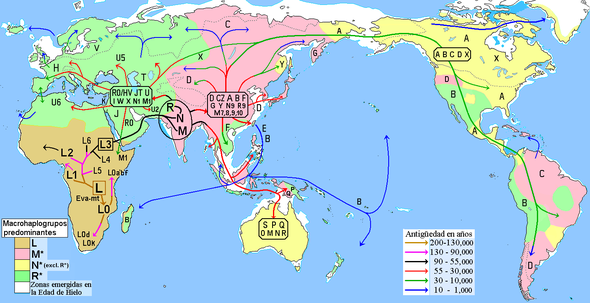Mitochondrial Eve
The mitochondrial Eve, according to human genetics, was an African woman who, in human evolution, would correspond to the most recent female common ancestor who possessed the mitochondria from which all mitochondria descend. the current human population, based on evidence of mitochondrial genome mutation rates.
Mitochondrial Eve is named after the Eve recounted in the Bible's book of Genesis. However, neither the name of "Eva" nor the term "Mitochondrial Eve" were employed by Allan Charles Wilson, Mark Stoneking, and Rebecca L. Cann, the authors of the original research titled "Mitochondrial DNA and Human Evolution," published in the journal Nature on January 1, 1987. Said article was accompanied by its respective notice, signed by Jim Wainscoat, with the title "Outside the Garden of Eden", which began to project the concept of "Eve" from the media. Subsequently, on January 26, 1987, Time magazine published a cover story, titled "Genealogical Mother of All: Biologists Speculate "Eve" lived in sub-Saharan Africa". Allan Charles Wilson himself preferred the term "One lucky mother", stating that the use of the name "Eva" it was unfortunate. The concrete term of "Mitochondrial Eve" first appeared on October 2, 1987, in an article in Science magazine written by Roger Lewin, titled "The Unmasking of Mitochondrial Eve". established itself in public opinion when Newsweek magazine of January 11, 1988 published an article titled "The Search for Adam and Eve", with a depiction of Adam and Eve on the cover.
By tracing the maternal lineage of each person in the family tree of all mankind, Mitochondrial Eve would correspond to a common female ancestor shared by the entire current population of human beings (Homo sapiens).
Based on the molecular clock technique, recent research (2009) estimates that this ancestor lived approximately 200,000 years ago, which corroborates the first calculations projected in 1987. The most likely region of origin is Africa Eastern.
A comparison of mitochondrial DNA from different ethnicities in different regions suggests that all sequences of this DNA are molecularly enveloped in a common ancestral sequence. Assuming that the mitochondrial genome can only be obtained from the mother, these findings would imply that all human beings have a common female ancestor through the purely maternal route when the first and most primitive Homo sapiens would have already existed, such such as Homo sapiens idaltu.
One of the most common mistakes is to believe that mitochondrial Eve was the only woman alive at the time of her existence and that she is the only woman to have had offspring to date. Nuclear DNA studies indicate that the size of the Ancient human population never fell below a few tens of thousands, and therefore there were many other women with living descendants to this day, but that somewhere in all their lines of descent there is at least one generation without issue. female, but male, therefore their mitochondrial DNA was not maintained, but their chromosomal DNA was.
Descent by mitochondrial lineage
This Eve is known because of the genome contained in the mitochondria (organelle present in all cells) that is only transmitted from mother to offspring. Each mitochondria contains mitochondrial DNA, and comparison of the sequences of this DNA reveals a molecular phylogeny.
When tracing the genealogical trees of the various populations that inhabit the planet with genetic mechanisms, matching branches (called haplogroups) are found in the different populations; until at a certain moment, in all of them, a common branch is found. This branch, by studying the age of genetic mutations, points to an African mitochondrial descent.
The smaller a population, the faster the mitochondrial DNA converges; the migrations of small groups of people drift (in what is called genetic drift) after a few generations towards a common mitochondrial DNA. This supports the theory of common origin, a theory that modern humans (Homo sapiens) originated in Africa between 100,000 and 200,000 years ago.
Relationship between mitochondrial Eve and chromosomal Adam
Just as mitochondria are inherited maternally, Y chromosomes are inherited paternally. Therefore, it is valid to apply the same principles with these. The closest common paternal ancestor has been nicknamed Chromosomal Adam. The first population genetics studies of the Y chromosome concluded that chromosomal Adam lived long after mitochondrial Eve, around 60,000 to 142,000, showing a discrepancy of more than 50,000 years between the two individuals. However, a study conducted by Stanford University substantially shortens the time difference between chromosomal Adam and mitochondrial Eve. The Stanford University team sequenced the Y chromosomes of 69 men from around the world and discovered nearly 9,000 hitherto unknown variations of the DNA sequence on the Y chromosome. They used these variations to create a more reliable molecular clock and found that Adam lived a minimum of 120,000 years ago and a maximum of 156,000 years ago. A comparative analysis of mitochondrial DNA sequences from the same men suggested that Eve lived between 99,000 and 148,000 years ago. This indicates that Chromosomal Adam existed before Mitochondrial Eve and probably lived around the same time period.
Mitochondrial Eve in Fiction
- In the final chapter Battlestar Galactica (Reimagined)It is speculated that Hera Agathon, the first Human/Cylon hybrid, was actually the Earth's Eve-mitochondrial.
- The sleeve Elfen Lied Lynn Okamoto, puts Lucy as the mitochondrial Eva of a new species.
- The story "Eva mitochondrial" within the collection Luminous Greg Egan's on the subject.
- The novel, horror movie and Japanese video game Parasite Eve uses mitochondrial theory as the basis for a story in which a scientist resurrectes his wife through regeneration of cells in the liver, with disastrous effects.
Contenido relacionado
Bothriochloa
Arundinaria
Andropogon

